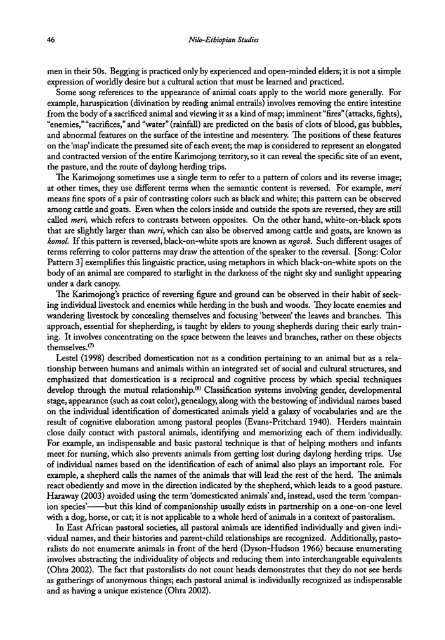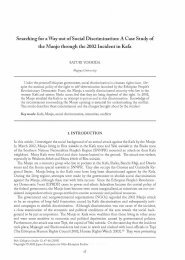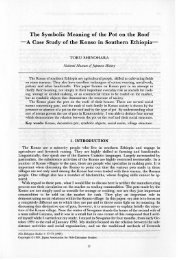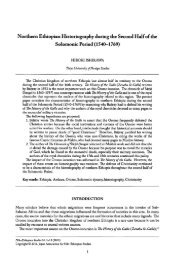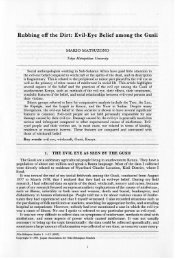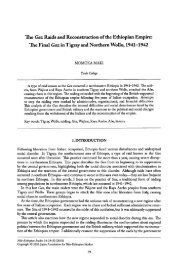Daily Life as Poetry: The Meaning of the Pastoral Songs of the ...
Daily Life as Poetry: The Meaning of the Pastoral Songs of the ...
Daily Life as Poetry: The Meaning of the Pastoral Songs of the ...
You also want an ePaper? Increase the reach of your titles
YUMPU automatically turns print PDFs into web optimized ePapers that Google loves.
46 Nilo-Ethiopian Studies<br />
men in <strong>the</strong>ir 50s. Begging is practiced only by experienced and open-minded elders; it is not a simple<br />
expression <strong>of</strong> worldly desire but a cultural action that must be learned and practiced.<br />
Some song references to <strong>the</strong> appearance <strong>of</strong> animal coats apply to <strong>the</strong> world more generally. For<br />
example, haruspication (divination by reading animal entrails) involves removing <strong>the</strong> entire intestine<br />
from <strong>the</strong> body <strong>of</strong> a sacrificed animal and viewing it <strong>as</strong> a kind <strong>of</strong> map; imminent "fires" (attacks, fights),<br />
"enemies," "sacrifices," and "water" (rainfall) are predicted on <strong>the</strong> b<strong>as</strong>is <strong>of</strong> clots <strong>of</strong> blood, g<strong>as</strong> bubbles,<br />
and abnormal features on <strong>the</strong> surface <strong>of</strong> <strong>the</strong> intestine and mesentery. <strong>The</strong> positions <strong>of</strong> <strong>the</strong>se features<br />
on <strong>the</strong> 'map' indicate <strong>the</strong> presumed site <strong>of</strong> each event; <strong>the</strong> map is considered to represent an elongated<br />
and contracted version <strong>of</strong> <strong>the</strong> entire Karimojong territory, so it can reveal <strong>the</strong> specific site <strong>of</strong> an event,<br />
<strong>the</strong> p<strong>as</strong>ture, and <strong>the</strong> route <strong>of</strong> daylong herding trips.<br />
<strong>The</strong> Karimojong sometimes use a single term to refer to a pattern <strong>of</strong> colors and its reverse image;<br />
at o<strong>the</strong>r times, <strong>the</strong>y use different terms when <strong>the</strong> semantic content is reversed. For example, meri<br />
means fine spots <strong>of</strong> a pair <strong>of</strong> contr<strong>as</strong>ting colors such <strong>as</strong> black and white; this pattern can be observed<br />
among cattle and goats. Even when <strong>the</strong> colors inside and outside <strong>the</strong> spots are reversed, <strong>the</strong>y are still<br />
called meri, which refers to contr<strong>as</strong>ts between opposites. On <strong>the</strong> o<strong>the</strong>r hand, white-on-black spots<br />
that are slighdy larger than meri, which can also be observed among cattle and goats, are known <strong>as</strong><br />
komol. If this pattern is reversed, black-on-white spots are known <strong>as</strong> ngorok. Such different usages <strong>of</strong><br />
terms referring to color patterns may draw <strong>the</strong> attention <strong>of</strong> <strong>the</strong> speaker to <strong>the</strong> reversal. [Song: Color<br />
Pattern 3] exemplifies this linguistic practice, using metaphors in which black-on-white spots on <strong>the</strong><br />
body <strong>of</strong> an animal are compared to starlight in <strong>the</strong> darkness <strong>of</strong> <strong>the</strong> night sky and sunlight appearing<br />
under a dark canopy.<br />
<strong>The</strong> Karimojong's practice <strong>of</strong> reversing figure and ground can be observed in <strong>the</strong>ir habit <strong>of</strong> seeking<br />
individual livestock and enemies while herding in <strong>the</strong> bush and woods. <strong>The</strong>y locate enemies and<br />
wandering livestock by concealing <strong>the</strong>mselves and focusing 'between' <strong>the</strong> leaves and branches. This<br />
approach, essential for shepherding, is taught by elders to young shepherds during <strong>the</strong>ir early training.<br />
It involves concentrating on <strong>the</strong> space between <strong>the</strong> leaves and branches, ra<strong>the</strong>r on <strong>the</strong>se objects<br />
<strong>the</strong>mselves.


